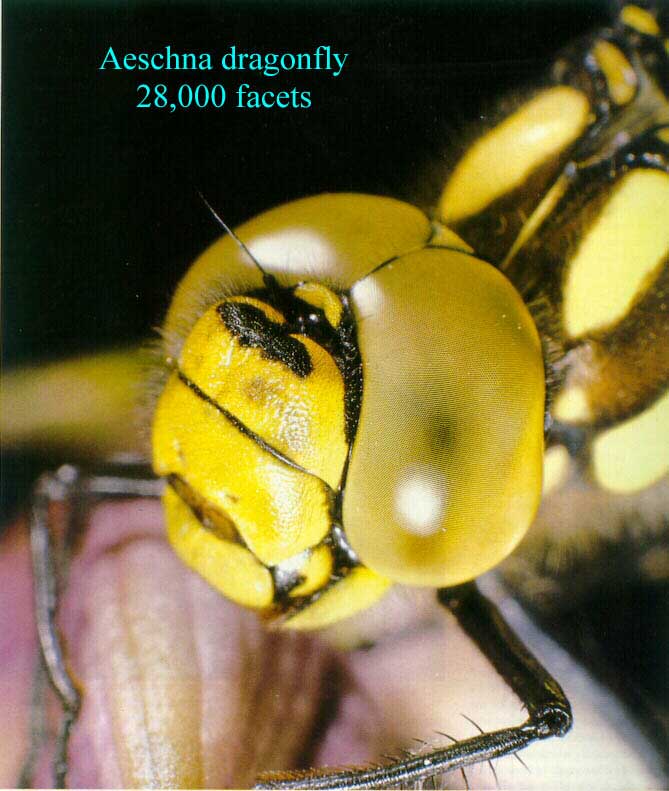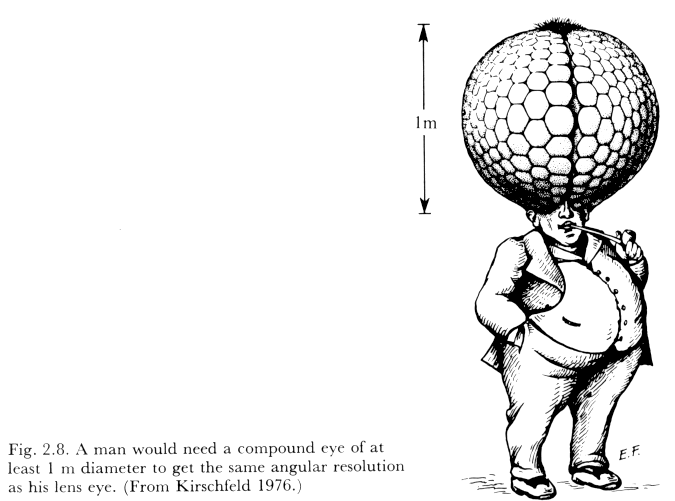Insects and humans (& in fact all other animals with eyes) use the same visual pigment – rhodopsin. But in other ways, insect & mammal eyes are fundamentally different. The insect eye is a compound eye that comprises many individual units, while ours is a camera-type eye. And these structural differences have a considerable impact on just how the owners of those eyes perceive their world.
Those differences hinge on how insect and vertebrate eyes evolved. The familiar camera-type eye originated as a ‘dimple’ – a small concave pit in the surface of the early vertebrate head. I’ve talked about this elsewhere (but it’s worth remembering that models for the evolution of our eye, from light-sensitive pit to complex eye equipped with lens & iris, may have occurred in as little as 400,000 years). Because of its structure, with a simple light-focussing mechanism and the lens separated from the retina by at least a few millimetres, the vertebrate eye is capable of seeing the world with considerable clarity.
From: http://www.cas.vanderbilt.edu/bsci111b/eye/supplemental.htm
Insects’ compound eyes, on the other hand, evolved from a collection of eyespots on a swelling on the head’s surface – in other words, they’re convex. Each of those individual eyespots has evolved into a structure called an ommatidium: a tube containing several light-sensitive cells and capped by a clear, curved coating that acts as a lens – a camera eye in miniature. Each ommatidium captures a tiny part of the available field of view, so that an insect must see a rather pixellated image of the world.
From: http://www.cas.vanderbilt.edu/bsci111b/eye/supplemental.htm
And, as with computer images, or photos, if you want a clearer image you have to have more pixels. The only way an insect could achieve this would be to have an eye with more, and smaller, ommatidia, so that each unit receives light from a smaller field of view. This is taken to its extreme in dragonflies – the one shown here has 28,000 ommatidia in each eye.
From: http://www.phys.ufl.edu/~avery/course/3400/vision/dragnfly_new.jpg
But there’s a trade-off. Even with so many ommatidia (& hence many more pixels in the image formed by the compound eye), an insect still gets a view of the world that’s nowhere near as clear as the one we see. The reason lies in the distance between the lens and the photoreceptors. In a human eye, this is a distance of some millimetres, and as a result each individual receptor cell (a rod or cone) receives light from a very narrow field of view. The overall resulting image is thus very fine-grained. But in an insect’s compound eye, lens & photoreceptor are only microns apart – each ommatidium still picks up light from a relatively wide field of view, & the image remains pixellated to some degree. Thos insects with the best vision (honeybees & dragonflies, for example) have longer ommatidia, which maximises the distance between lens & receptor. The outcome is those enormously bulging eyes.
If our eyes were compound ones, just how big would they have to be to provide the same degree of visual acuity as the compound eyes we actually have? The imag below says it all – such a compound eye would need to be a staggering one metre across! (The makers of the horror film The Fly didn’t quite get that one right!)
from: http://www.phys.ufl.edu/~avery/course/3400/vision/compound_eye_man.gif




sadok says:
Allow me to echo the “fantastic idea” sentiment!
This is a fantastic thing, and would have WONDERFUL applications outside, say, a tourist interpretation centre for a national park, or the downtown of a city!
Alison Campbell says:
thanks for the comments – did you mean them for the ‘Fieldays’ post? (A guy with eyes a meter across would cause chaos in the city centre 🙂 !)